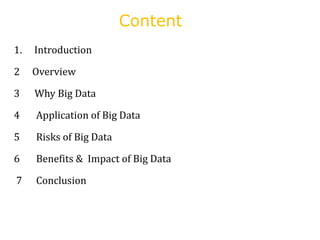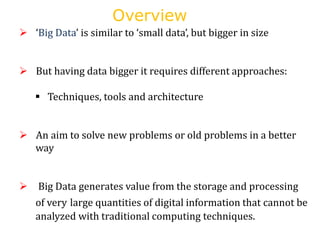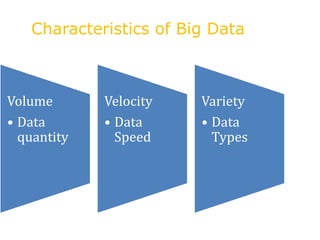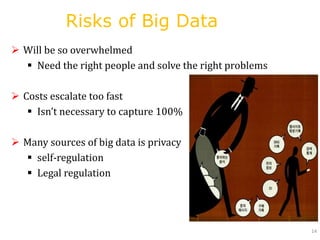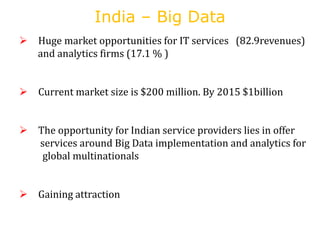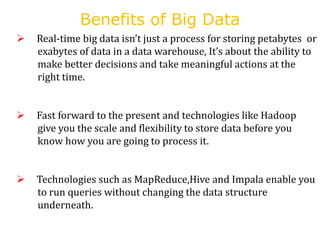BIG DATA & DATA ANALYTICS
- 1. Submitted By: Nagaraja G Final CSE SJCET,Yerrakota BIG DATA & DATA ANALYTICS
- 2. Content 1. Introduction 2 Overview 3 Why Big Data 4 Application of Big Data 5 Risks of Big Data 6 Benefits & Impact of Big Data 7 Conclusion
- 3. Introduction Big Data may well be the Next Big Thing in the IT world. Big data burst upon the scene in the first decade of the 21st century. The first organizations to embrace it were online and startup firms. Big data can bring about dramatic cost reductions, substantial improvements in the time required to perform a computing task, or new product and service offerings.
- 4. Overview ‘Big Data’ is similar to ‘small data’, but bigger in size But having data bigger it requires different approaches: Techniques, tools and architecture An aim to solve new problems or old problems in a better way Big Data generates value from the storage and processing of very large quantities of digital information that cannot be analyzed with traditional computing techniques.
- 5. Characteristics of Big Data Volume • Data quantity Velocity • Data Speed Variety • Data Types
- 6. Storing Big Data Selecting data sources for analysis Eliminating redundant data Establishing the role of Data models Selecting Big Data Choosing the correct data stores based on your data characteristics Processing Big Data Integrating & Mapping data Connecting and extracting data from storage Transforming data for processing
- 7. The Structure of Big Data Structured Most traditional data sources Semi-structured Many sources of big data Unstructured Video data, audio data 7
- 8. Why Big Data Growth of Big Data is needed Increase of storage capacities & Processing power Availability of data(different data types) Every day we create 2.5 quintillion bytes of data; 90% of the data in the world today has been created in the last two years alone
- 9. Why Big Data FB generates 10TB daily Twitter generates 7TB of data Daily IBM claims 90% of today’s stored data was generated in just the last two years.
- 10. Big Data sources Exploiting known security vulnerabilities Systems Back doors Large and growing files (Big data files)
- 11. Data generation points Examples Mobile Devices Readers/Scanners Science facilities Microphones Cameras Social Media Programs/Software
- 12. Big Data Analytics Examining large amount of data Appropriate information Identification of hidden patterns, unknown correlations Competitive advantage Better business decisions: strategic and operational Effective marketing, customer satisfaction, increased revenue
- 13. Application Of Big Data analytics Homeland Security Smarter Healthcare Multi channel Telecom Manufactur ing Traffic Control Trading Analytics Search Quality
- 14. Risks of Big Data Will be so overwhelmed Need the right people and solve the right problems Costs escalate too fast Isn’t necessary to capture 100% Many sources of big data is privacy self-regulation Legal regulation 14
- 15. Leading Technology Vendors Example Vendors IBM – Netezza EMC – Greenplum Oracle – Exadata Commonality MPP architectures Commodity Hardware RDBMS based Full SQL compliance
- 16. How Big data impacts on IT Big data is a troublesome force presenting opportunities with challenges to IT organizations. By 2015 4.4 million IT jobs in Big Data ; 1.9 million is in US itself India will require a minimum of 1 lakh data scientists in the next couple of years in addition to data analysts and data managers to support the Big Data space.
- 17. Potential Value of Big Data $300 billion potential annual value to US health care. $600 billion potential annual consumer surplus from using personal location data. 60% potential in retailers’ operating margins.
- 18. India – Big Data Huge market opportunities for IT services (82.9revenues) and analytics firms (17.1 % ) Current market size is $200 million. By 2015 $1billion The opportunity for Indian service providers lies in offer services around Big Data implementation and analytics for global multinationals Gaining attraction
- 19. Benefits of Big Data Real-time big data isn’t just a process for storing petabytes or exabytes of data in a data warehouse, It’s about the ability to make better decisions and take meaningful actions at the right time. Fast forward to the present and technologies like Hadoop give you the scale and flexibility to store data before you know how you are going to process it. Technologies such as MapReduce,Hive and Impala enable you to run queries without changing the data structure underneath.
- 20. Benefits of Big Data Our newest research finds that organizations are using big data to target customer-centric outcomes, tap into internal data and build a better information ecosystem. Big Data is already an important part of the $64 billion database and data analytics market It offers commercial opportunities of a comparable scale to enterprise software in the late 1980s And the Internet boom of the 1990s, and the social media explosion of today.
- 21. Conclusion $15 billion on software firms only specializing in data management and analytics. This industry on its own is worth more than $100 billion and growing at almost 10% a year which is roughly twice as fast as the software business as a whole. In February 2012, the open source analyst firm Wikibon released the first market forecast for Big Data , listing $5.1B revenue in 2012 with growth to $53.4B in 2017 The McKinsey Global Institute estimates that data volume is growing 40% per year, and will grow 44x between 2009 and 2020.
- 22. ANY QUERIES…?
- 23. Thank You

